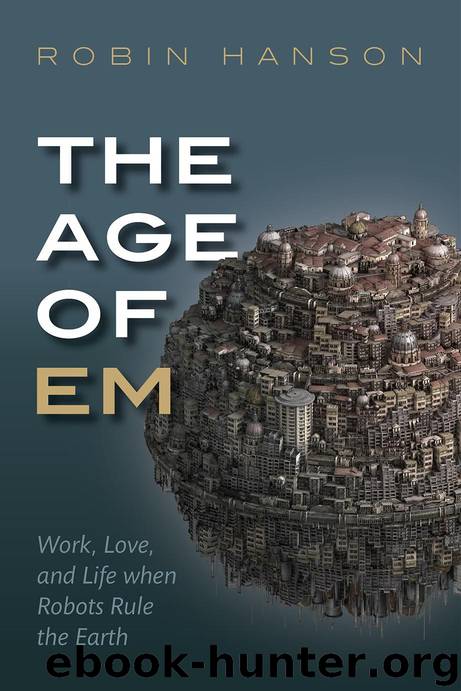The Age of Em: Work, Love and Life when Robots Rule the Earth by Robin Hanson

Author:Robin Hanson [Hanson, Robin]
Language: eng
Format: epub
Publisher: OUP Oxford
Published: 0101-01-01T00:00:00+00:00
City Structure
We can say things not only about the number and size of em cities, but also about internal em city structures.
In virtual meetings, ems care little about being much closer than the reaction distance from a city center. Remember, reaction distance is how far light travels in a mental reaction time. As faster ems have shorter reaction distances, they thus gain more value from congregating closer to city centers. So faster ems should cluster more centrally, surrounded by slower ems toward the periphery. This is similar to how today investors using higher frequency trading algorithms often pay more to locate close to financial market centers. The higher values gained by fast ems are reflected in higher rental prices for central real estate, which should induce a denser packing of computing power, energy inputs, and cooling in em city centers.
In the last few decades, falling costs of long-distance travel have induced a great increase in the rate of conferences and business meetings. Compared with the residents of our cities, ems who are within a reaction distance of one another have low costs of traveling to attend virtual meetings. This should greatly increase the rate of conferences and business meetings, especially for slower ems.
Because of rising prices to rent space near city centers, the total hardware cost per subjective minute of em experience is higher toward city centers. Thus ems who tend to choose more central locations when they run faster face a more than proportional effective hardware cost as a function of speed. Because of this, ems who get less value from many fast interactions with other ems tend to locate toward the peripheries of em cities.
If faster ems tend to locate closer to city centers, if ems tend to cluster spatially near others of the same speed, and if em speeds tend to fall into discrete classes, then em cities may break into discrete speed neighborhoods. Each neighborhood runs mostly at its own different speed. These neighborhoods might plausibly be arranged in rings around the city center, or perhaps in a fractal structure around many levels of urban centers.
If ems sometimes inhabit physical bodies with sizes matched to their speed, then cities may have matching physical infrastructure such as sidewalks, bridges, and doorways. These may be smaller toward city centers, where the faster ems reside. Physical barriers that enforce differences in air pressure between different city regions might perhaps also be good places to change the typical physical scale of infrastructure. In this case, inner regions with smaller scale infrastructure also have higher pressures.
Today, larger cities tend to have better educated, more social, and more productive workers. Bigger cities less often specialize in particular industries and occupations (Duranton and Jayet 2011). Big city workers also tend to do tasks that are more connected to other tasks, and so benefit from being located close to each other (Kok and ter Weel 2014). Cities grow faster when their workers do more connected tasks, and when these workers connect more via social media (Mandel 2014).
Download
This site does not store any files on its server. We only index and link to content provided by other sites. Please contact the content providers to delete copyright contents if any and email us, we'll remove relevant links or contents immediately.
| Computer Vision & Pattern Recognition | Expert Systems |
| Intelligence & Semantics | Machine Theory |
| Natural Language Processing | Neural Networks |
Algorithms of the Intelligent Web by Haralambos Marmanis;Dmitry Babenko(8599)
Test-Driven Development with Java by Alan Mellor(7592)
Data Augmentation with Python by Duc Haba(7483)
Principles of Data Fabric by Sonia Mezzetta(7243)
Learn Blender Simulations the Right Way by Stephen Pearson(7170)
Microservices with Spring Boot 3 and Spring Cloud by Magnus Larsson(6993)
RPA Solution Architect's Handbook by Sachin Sahgal(6396)
The Infinite Retina by Robert Scoble Irena Cronin(6101)
Hadoop in Practice by Alex Holmes(6063)
Jquery UI in Action : Master the concepts Of Jquery UI: A Step By Step Approach by ANMOL GOYAL(5915)
Big Data Analysis with Python by Ivan Marin(5849)
Life 3.0: Being Human in the Age of Artificial Intelligence by Tegmark Max(5457)
Pretrain Vision and Large Language Models in Python by Emily Webber(4806)
Infrastructure as Code for Beginners by Russ McKendrick(4589)
WordPress Plugin Development Cookbook by Yannick Lefebvre(4302)
The Age of Surveillance Capitalism by Shoshana Zuboff(4199)
Functional Programming in JavaScript by Mantyla Dan(4175)
Embracing Microservices Design by Ovais Mehboob Ahmed Khan Nabil Siddiqui and Timothy Oleson(4075)
Applied Machine Learning for Healthcare and Life Sciences Using AWS by Ujjwal Ratan(4054)
